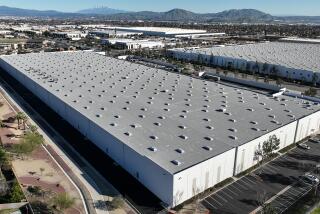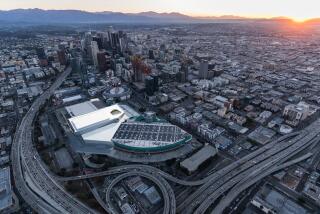Interim Curbs Placed on New Mini-Malls : Development: Congestion prompts officials to obtain more review powers on small-scale shopping centers.
- Share via
NORWALK — The City Council moved Tuesday to control the proliferation of mini-malls and small office buildings that contribute to traffic and parking problems on city streets.
The council voted 4 to 1 to require developers to obtain conditional-use permits before they are allowed to build stores or offices on tiny lots. That gives the city’s Planning Commission veto power over such projects.
The interim ordinance passed by the council remains in effect for 45 days. The council must have a public hearing to extend the ordinance beyond that period.
“It’s an additional layer (developers) have to go through,” said Gregg Yamachika, the city’s acting director of community development. “It gives us more review power over these smaller developments.”
City planners originally proposed an immediate moratorium on the construction of mini-malls and small office buildings. But it became evident that the proposal did not have adequate support, and the council did not vote Tuesday on the moratorium. Such a moratorium must receive four-fifths approval from the council.
Councilman Robert E. White opposed the moratorium because he said it could discourage development in the city. Mayor Luigi A. Vernola, who favored a moratorium, would have had to abstain because he owns commercial property in the city--a potential conflict of interest, according to City Atty. Steven L. Dorsey.
As an alternative, Councilman Mike Mendez proposed the interim ordinance requiring a conditional-use permit. Dorsey gave Vernola approval to vote on that proposal. White cast the lone vote against requiring a conditional-use permit for such projects.
Yamachika said four developers and their proposed projects would be immediately affected by council action.
Only one community member spoke against the moratorium. Mike Poff, president-elect of the Norwalk/La Mirada Board of Realtors, said the final council action was the better of two evils.
“The city ought to keep their noses out of commercial developers’ business,” Poff said. “It will be tougher, harder and take longer to develop property, but it’s better than grinding to a halt.”
City planners say the construction of more of the diminutive malls and offices could smother efforts to concentrate commercial and large office complexes in key locations, such as the Civic Center.
“What is happening is we’re seeing land recycled, older commercial buildings being torn down and these newer developments put in,” Yamachika said. “What we’re trying to do at this point is to put the brakes on future development and say, ‘Is this a pattern we want to continue in the future?’ ”
Auto parts stores, barbershops, drapery and glass shops and furniture and sporting goods stores sprouted along Norwalk’s major streets decades ago. The mini-malls followed.
In the past, traffic flowed smoothly along Imperial Highway, Rosecrans Avenue and Firestone Boulevard. But the city’s population has since swelled to more than 94,000, according to the 1990 U.S. Census, and vehicles often clog Norwalk’s major roadways.
The tiny malls, shops and offices with a myriad of driveways and on-street parking contribute to the traffic jams along the city’s main street, Yamachika said.
City planners say it makes more sense to channel shoppers into large shopping centers and office complexes.
“We want to look at a new land-use policy and try to clump them in nodes,” Yamachika said.
Norwalk officials have also been alarmed about the high vacancy rate of the city’s mini-malls and small office buildings. City officials do not have precise figures, but they estimate vacancy rates at 20% to 30%.
“They build them and they stay empty for a long time,” Vernola said of the mini-malls. “We’re overbuilding all the little corners. How are they going to attract more people than the guy around the block?”
City officials say the Civic Center area is probably the best place for major commercial and office development.
The Civic Center includes City Hall, the Southeast Municipal Courthouse, a county Library, a Sheriff’s Department station and two large office buildings. City officials have also talked about trying to expand the Paddison Square shopping center, which is across the street.
The city’s other major commercial center is the recently renovated Norwalk Square at the intersection of Rosecrans Avenue and Pioneer Boulevard.
Despite the recession, city officials say there could be a need for more office space and a major shopping center once the Green Line light rail system is completed in 1994. The commuter train will run down the center of the Century Freeway, which is under construction.
The Century Freeway and the Green Line are to end in western Norwalk. City officials are talking with county transportation officials about the possibility of extending the light rail line through the Civic Center.
The extension “makes a lot of sense in terms of our land-use plans around the Civic Center area,” said Dan Keen, deputy city manager.
Community correspondent Suzan Schill contributed to this story.
More to Read
Sign up for Essential California
The most important California stories and recommendations in your inbox every morning.
You may occasionally receive promotional content from the Los Angeles Times.










